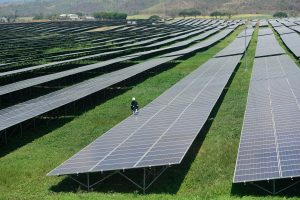THE Department of Energy (DoE) said it will take time for the Philippines to transition to 100% renewable energy (RE), and called for the industry to be more honest about how long the shift will take.
“For those who are saying that we can go 100% renewable overnight, then I would like to have more honesty from this sector that we are not in a position to do it,” Energy Secretary Raphael P.M. Lotilla said at the BusinessWorld Insights forum last week at the Shangri-La in Bonifacio Global City.
Mr. Lotilla said that while the government continues to work on expanding renewable energy use, the energy transition will take time.
“The energy transition has to take place over time if it is going to be a just transition. But if we are simply going to do away with (legacy technologies) overnight, then these are going to be lost investments as far as the economy is concerned,” Mr. Lotilla said.
He said that the government recognizes that renewable energy is the way forward for attaining security, sustainability and affordability of energy prices.
“That doesn’t mean that we are not committed to the transition, but we have to do it in a just and fair way, which is to ensure that variable renewable energy is (complemented) by energy storage systems as well as other sources of power and technology,” Mr. Lotilla said.
He said that the effective implementation of energy efficiency and conservation measures is an equally important aspect of the government’s energy programs.
“The effective implementation of energy efficiency to bring down overall energy consumption, lower greenhouse gas emissions… sustainable development goals require a change in lifestyle, a change in consumption patterns,” Mr. Lotilla said.
“Energy efficiency is the one pillar of the energy sector that we have to grow aggressively,” said Alexander D. Ablaza, president of Philippine Energy Efficiency Alliance and chief executive officer of Climargy, Inc.
President Ferdinand R. Marcos, Jr. said in his second State of the Nation Address that the government will need to accelerate its programs to attain the goal of increasing the share of renewable energy to 35% by 2030 and 50% by 2040.
As of end of 2022, renewable energy accounts for about 22% of the energy mix, with coal-fired power plants accounting for almost 60%.
Pedro H. Maniego, Jr., senior policy advisor of the Institute for Climate and Sustainable Cities said that the Philippines has still a long way to go from achieving its Philippine Energy Plan targets.
“We need to act more aggressively and more urgently, as Filipinos have borne the brunt of expensive and unreliable power for years. Renewable energy sources are free, indigenous, and have no supply limitations, and increasing its share in the Philippine energy mix ensures more affordable, reliable, and secure power for Filipinos,” Mr. Maniego said in a statement.
Mr. Maniego has identified the long approval process of the National Grid Corp. of the Philippines (NGCP) for system impact studies (SIS) and the lack of interconnection as major causes of delay in advancing renewable energy projects.
Separately, Mr. Lotilla said that the SIS process needs to be improved further and that the DoE is proposing to shorten the approval timeline to 60 days.
The NGCP said it is currently carrying out a “comprehensive series of actions” to address “the lengthy SIS queue” for power plant connections.
The SIS assesses how adding new energy sources impact the grid. It also helps identify the needed improvements like additional transmission lines, transformers, or substations.
“Generation project proponents who are first in line for SIS are not necessarily first to be ready with complete requirements. In fact, many request time extensions, which also contributes to the prolonged SIS processing time,” Anthony L. Almeda, president and chief executive officer of NGCP, said in a statement. — Ashley Erika O. Jose

